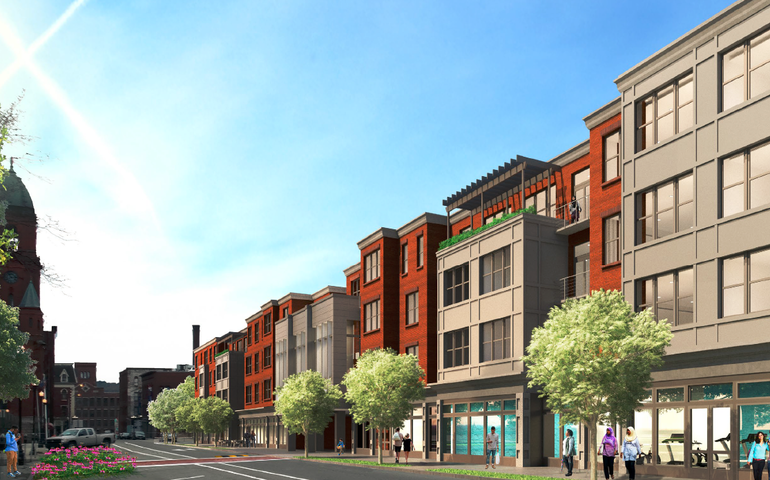
Lewiston is national finalist for transformative $30M Choice Neighborhood grant
 Courtesy / City of Lewiston
A rendering shows housing rehabilitation in downtown Lewiston that would be possible with the $30 million Choice Initiative grant.
Courtesy / City of Lewiston
A rendering shows housing rehabilitation in downtown Lewiston that would be possible with the $30 million Choice Initiative grant.
Lewiston is a national finalist, competing with four other cities, for a $30 million grant that would have a major impact on housing, education, health and more in residential areas of downtown.
The city is competing with Detroit, Cleveland, Camden, N.J., and Fort Myers, Fla., for the U.S. Department of Housing and Urban Development’s Choice Neighborhoods Initiative grant.
The money would not only build 185 new units of affordable housing in Lewiston's Tree Streets neighborhood, but also kickstart health, safety and workforce improvements.
The city got a $1.3 million planning grant from the program in 2018 and another $75,000 from MaineHousing in November to finish the grant application. The applicants are the Lewiston Housing Authority and city of Lewiston, in partnership with Community Concepts. The Gorman Foundation also has supported the project, including funding a consultant who helped write the grant application.
The real force behind the success so far, though, has been the residents of the neighborhood, said Lincoln Jeffers, the city's economic development director.
"We're fortunate to have had hundreds of citizens engaged in this," he told Mainebiz Tuesday morning. "It's not about City Hall saying 'here's how to fix your neighborhood,' it's about the citizens envisioning what kind of neighborhood they want to have."
If the city wins the grant, 70% goes to housing; 15% for "people," including things like health care access and food security; and 15% to neighborhood beautification. The grant would fund a 25-year plan that replaces housing, some more than a century old, with efficient, healthier units, and more. The improvements are outlined in the 250-page Growing Our Tree Streets plan approved by the City Council in 2019.
Jeffers said it's a step beyond the decades-old HUD model of building affordable housing, that's then maintained to a certain extent, but nothing more happens.
"We need to change that model," he said. "This is not just about housing, it's about the need to build opportunity."
The grant is designed to transform neighborhoods that are dealing with distressed housing, inadequate schools, poor health, high crime and lack of capital. The area of downtown Lewiston the grant focuses on has the state's highest concentration of childhood lead poisoning, families in poverty.

Replacing distressed housing, and more
Lewiston's plans are to replace 92 "severely distressed" public and assisted housing units "and the systematic, block-by-block replacement of the century-old, obsolete, lead-poisoned tenements that now dominate the Tree Streets housing market," it's summary says.
"In their place will be modern, safe, amenity-rich, and highly energy-efficient residences that a diversity of current and future residents can call home."
The team behind the grant application has assembled 18 parcels of vacant land and structures in three neighborhood gateway locations to be used for replacement housing. Plans are for 185 new multifamily units: 92 replacement, 38 workforce to be built using low income housing tax credits and 55 unrestricted.
In general, the sites targeted by the grant represent 100% of the family housing downtown controlled by the Lewiston Housing Authority. Two-thirds were originally constructed in the 1880s through 1920s as wood-frame mill-worker tenements, and all are severely distressed, according to the grant application. The sites include:
- Maple Knoll, a 39-unit complex, with 31 HUD-assisted apartments. Originally constructed as two separate four-story walk-ups in the 1890s, the structures were combined in a 1970s renovation.
- Lafayette Park, a 30-unit public housing development with one to three-bedroom units in five two-story buildings constructed in 1982 on a 2.5-acre lot.
- Tree Streets scattered sites, 21 public housing units in six buildings in the neighborhood between Maple Knoll and Lafayette Park. All of the buildings were constructed between the 1880s to 1920s and rehabbed for low-income housing in 1985.
The decision is expected to be made by the end of April or early May, Jeffers said. In the coming weeks, a HUD team will hold virtual site visits of the five finalists.
Jeffers said that while the grants traditionally go to large cities, Lewiston has worked with HUD for years, and the department is familiar with the city.
He said that while Lewiston is competing with much larger cities, the fact that it's gotten this far is a reflection of years of hard work by those involved. He said that even if Lewiston doesn't get the $30 million grant, there's now a template for improving downtown for its residents.
"The effort was well worth it," he said. "We have something to move forward with."









0 Comments